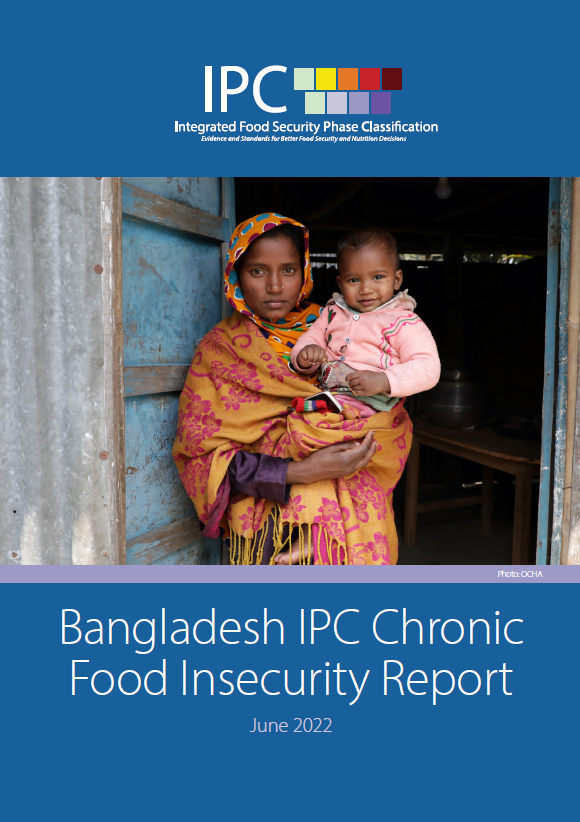15.06.2022
01.12.2019 > 30.11.2024
Key
results
Recommendations
& next steps
Acute
Malnutrition
Bangladesh has made significant progress in food security in recent years compared to many of its Asian counterparts, with over 58.5 million people, representing 36% of the total population, facing Mild Chronic Food Insecurity (IPC Level 2), and almost 70 million people, representing 43% of the total population, classified in IPC Level 1 (No Chronic Food Insecurity).
Nearly 35 million people, representing 21% of the total population of Bangladesh, face Moderate and Severe Chronic Food Insecurity (IPC Levels 3 and 4), of which 11.7 million people, or 7% of the total population face Severe Chronic Food Insecurity (IPC Level 4) and 23.2 million people, or 14% of the total population, face Moderate Chronic Food Insecurity (IPC CFI Level 3).
Of the eight divisions in Bangladesh, the divisions of Chattogram and Dhaka have the lowest proportion of Moderate and Severe Chronic Food Insecure (CFI) people (19% and 16% respectively). Rangpur division has the highest proportion of Moderate and Severe CFI people (31%) followed by Mymensingh division (26%) and Barishal division (24%).
At the next administrative level, of the 64 districts in Bangladesh, there are six districts that have a share of households equal to 35% or more in IPC CFI Levels 3 and 4. These are: Bandarban, Jamalpur, Kurigram, Gaibandha, Sunamganj and Cox’s Bazar. In four districts - Chattogram, Dhaka, Mymensingh, and Gaibandha - the total population in IPC CFI Levels 3 and 4 is greater than 1 million. These districts are analysed in greater detail in this report.
Households with the highest risk of IPC CFI Levels 3 and 4 are those who mainly depend on low value and unsustainable income sources (which often generate inadequate and unpredictable income), such as unskilled daily labor, marginal farming or traditional/subsistence fishing, (ARSS, 2018) and live in areas where there is a high recurrence of shocks, e.g., cyclones, flash and monsoon floods, riverbank erosion, dry spells, etc. These households are likely to possess the lowest levels of human (ARSS, 2018), physical (HIES, 2016) and financial capitals (Statistical Yearbook 2018).
Country Related Information
Contacts
- 01.02.2024 > 31.10.2024
Bangladesh: Acute Food Insecurity Situation for February - March 2024 and Projection for April - October 2024 - 01.03.2023 > 30.09.2023
Bangladesh: Acute Food Insecurity Situation for March - April 2023 and Projection for May - September 2023 - 01.06.2016 > 30.04.2017
Bangladesh: Acute Food Insecurity Situation for June-November 2016 and Projection for January-April 2017 - 01.12.2015 > 31.12.2020
Bangladesh: Chronic Food Insecurity Situation 2015-2020 - 01.09.2014 > 31.12.2014
Bangladesh: Acute Food Insecurity Situation September - December 2014 - 01.08.2013 > 31.10.2013
Bangladesh: Acute Food Insecurity Situation August - October 2013 - 01.12.2012 > 31.12.2012
Bangladesh: Acute Food Insecurity Situation in December 2012 (Coastal Zones)
- 05.02.2024 > 12.02.2024
Bangladesh: Acute Food Insecurity - 15.03.2023 > 20.03.2023
Bangladesh: Acute Food Insecurity Analysis - 03.11.2019 > 08.11.2019
Bangladesh: Chronic Food Insecurity Analysis - 28.04.2019 > 02.05.2019
Bangladesh: Chronic Food Insecurity Level 1 Training
Join our mailing list


